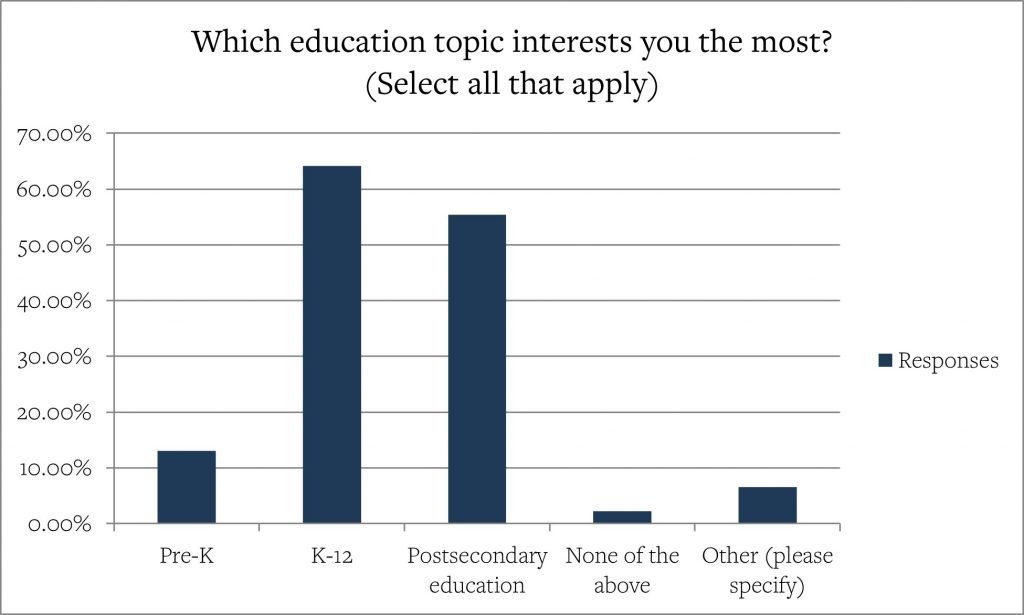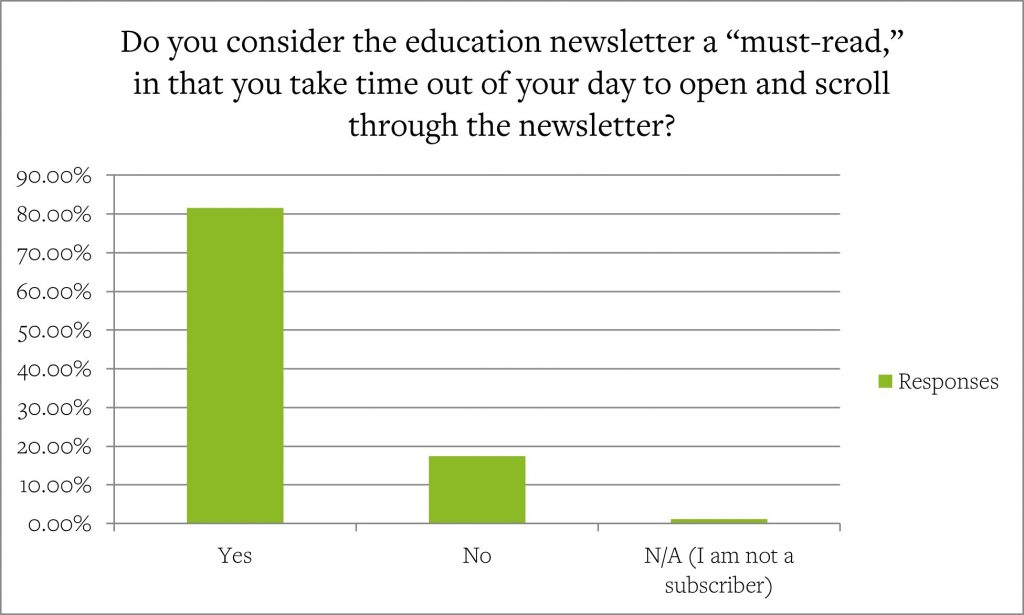Who comprises our audience? Are we communicating in formats that our audience wants? Is our audience engaged, in that we’re communicating on topics of interest and relevance? Are we having an impact in the field?
These are the critical questions the Christensen Institute’s education team aimed to answer in its inaugural readership survey, conducted February 1-15, and which received 92 responses. To all those who took precious time out of their hectic schedules to respond, we extend our sincerest gratitude. After all, web analytics can only tell us so much—to make a difference for our readers, we need to hear your perspectives to help guide our work.
As we eagerly went through your responses, there were some insights we suspected but were good to confirm, such as most of you currently reside in the US (98%); more than half are practitioners (51%), followed by nonprofit professionals (28%); and most are interested in a mix of K–12 (64%) and postsecondary (55%) content. This year and into the future, our hope is to continue to expand and diversify our audience to accurately represent the education space as it continuously expands and diversifies.

However, many insights were not only incredibly informative in how we can improve our work, but in lifting the hood on the demands of your jobs and how we can better help you perform them. Below, we delve into the three key takeaways from your input, and how the education team is responding.
What we learned
1. You need help.
Of the open-response questions, “What are the three biggest challenges in your work” had the most consistent responses across all respondents. Your biggest work challenge? 1) You’re short on time (you truly have none to spare), 2) you need more resources to inform your work, and 3) you need help getting buy-in for our theories and research from your colleagues and the field.
2. Our content’s good; it could be great.
What was heartening to hear is that, overall, most respondents consider our bi-weekly education newsletter a “must-read,” in that they take time out of their day to read it (83%). Over half have also cited our work in their research or within their work within the last three years (69%), and a fair amount of you say there’s nothing to improve (31%).

This data doesn’t imply perfection, however—some respondents indicate that our newsletter isn’t a must-read. To ensure efficiency in our improvement efforts, we weighted responses from those readers on how we can improve our content’s relevance.
3. We should expand our content scope while providing real-world examples.
As a research institution, analysis is one of our main value-adds to the field, and we made sure to ask multiple open-ended questions to better assess engagement around this content.
When asked “What topics would you like to read about more frequently or more in-depth?” the majority of you cited what we call “field tangibles” (22%), such as innovations at scale, examples of disruptive innovation in the real world, effective practices, and leadership profiles. “Student wellbeing” (13%) was next and included topics like social and emotional learning, mental health, wraparound supports, and family engagement. Finally, many asked for more “insights for the future” (11%), such as ideas around future planning and research insights that you can apply now for the future.
When we asked respondents for “Any suggestions for how we can improve the relevance of our blogs or research for you?” as noted above, we weighted the responses from those who indicated that perhaps our content wasn’t as relevant as it could be. Overall, our content can improve by expanding our scope internationally and within higher education (19%); including more voices from the field and evidence-based case studies (12%); and focusing more on equity, accessibility, and social and emotional learning (7%). This last recommendation is tied with respondents’ call to collaborate more with other institutions, organizations, and schools (7%).
What we’re doing
Summarizing your helpful responses, we believe the top three calls-to-action are to: expand our reach, optimize our content for time, and help our readers ensure buy-in for our research and theories.
In response to these action items, the education team spent time crafting potential strategies and considerations toward enhancing our work. Here’s what’s currently In the works:
- By the end of March, publish the first “Innovation in Action” series contributed blog that profiles how a school, institution, or organization is implementing or scaling an innovation, and why they believe the innovation is critical for students.
- This spring, finalize a series of case studies showcasing how innovative K–12 schools are breaking the bounds of conventional education.
- By this summer, have a start sourcing a student voice repository that can humanize and add relevance to our research, blogs, and contributed content.
- Within the next year, prioritize collaborating with other nonprofits and media outlets for potential collaboration and co-branded events.
- When possible, include evidence of outcomes (nonacademic outcomes included) and evidence of effective scale in our content.
- As we consider research topics, prioritize the inclusion of issues concerning equity, accessibility, and socioeconomics.
And here’s what’s currently in consideration:
- Within the year, create a resource directory on our website that houses our numerous “101” explanations of our theories in one easily accessible destination.
- Continue to think strategically about writing blogs that filter key takeaways from our longer research reports that many may not have time to read thoroughly.
- Provide a resource list at the bottom of blog posts whenever possible.
- Create a bulleted “takeaways” section at the top of each blog post to make our content more accessible and digestible for time-strapped readers.
Your insightful comments and suggestions continue to inspire and motivate the education team to produce work that has a lasting impact on you, your work, and the field. While this blog post provides initial steps toward that impact, we will continue to assess and iterate on our strategy over time.
Also, we invite you to reach out with any questions, comments, or suggestions outside of our surveys! Please contact me at [email protected] with your thoughts.


